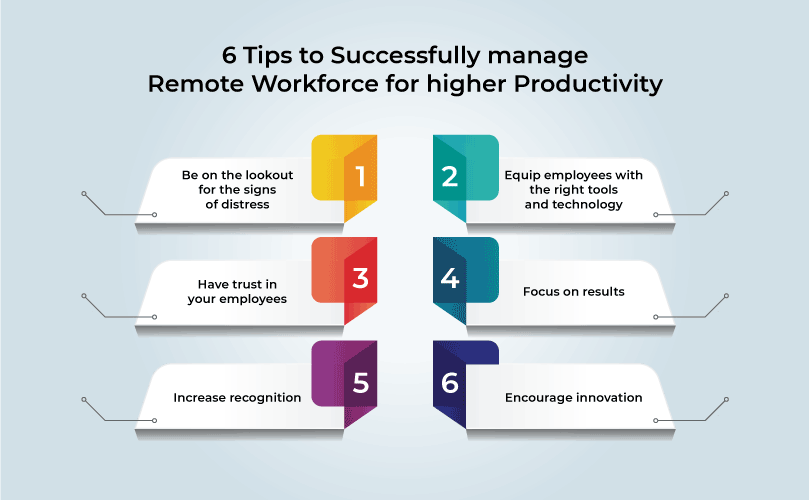
According to one estimate, nearly 36.2 million Americans could work remotely by 2025, reducing commuter miles by 70 to 140 billion annually. Moreover, 74% of 2,050 full-time remote workers said working from home feels better for their mental health. This means that the remote work that came with the pandemic is only here to stay & learning how to manage a remote workforce is a must for managers!
As a manager, you might find managing your remote employees difficult, primarily when you are used to seeing them in person daily at the office. But since remote work is not going anywhere, you should consider learning new ways to manage today’s remote teams.
This article will first discuss some advantages and disadvantages of remote employees. And then, we will look at six tips on how to manage a remote workforce efficiently.
What is a Remote Workforce?
In simple terms, if your employees are spread across various locations and work from there, you have a remote workforce. These employees could be working from the comfort of their homes and may visit your office facilities once in a while, or they could be spread across different countries and work 100% digitally.
What are the advantages and disadvantages of remote employees?
Just like anything else, having a global remote workforce has pros and cons. Let us look at some of them here –
1. Work-life balance
Advantage
We all know how important having a good work-life balance is to stay stress-free. Working remotely allows employees to have that. They don’t have to spend long hours in commute or worry about the clothes they will wear the next day to work. The remote workforce enjoys the comfort of their home and working in their comfortable clothes. They get more time to spend with their family, friends, and even with themselves, and all of this adds to a good work-life balance.
Disadvantage
For many employees, remote work means an imbalanced work-life. Work can quickly take over personal life if there are no boundaries. It can start with replying to just one email after work hours or trying to finish the task at hand even if the work hours are over. All this can make a typical work day last for more than 10 hours leading to an imbalanced work-life and a stressed and exhausted remote workforce.
2. Flexibility
Advantage
Remote employees enjoy the flexibility that comes with remote work. They have the option to work from their home or a coffee shop, and they can even work while sitting on a beach. Having flexible work hours only adds to the benefit as some night owls can finish their work at night. This flexibility also enables employers to attract candidates while hiring.
Disadvantage
Having flexibility sounds all fun until the distractions that come with it start hampering productivity. Ringing doorbells, dogs asking you to play with them, and household chores are just some distractions that can take away all your productivity.
3. Collaboration
Advantage
Having a global remote workforce spread across cities and countries means you get to work with people from various cultures and backgrounds. Such a diverse team makes collaborative projects exciting, as everyone brings something unique to the table. Besides, working with an international team helps employees develop a cultural understanding which allows them to value different points of view.
Disadvantage
When the pandemic hit, and everyone was forced to work remotely, communication and collaboration were the managers’ top concerns. It meant that the managers couldn’t just walk up to their employees’ desks to take an update and had to schedule virtual meetings to discuss routine projects. Virtual communication also took away the chance to bond with employees and develop an understanding.
4. Culture
Advantage
When a business allows remote work, it shows that it is concerned about its employees’ well-being and enables them to work from their time and place of comfort. It is a major benefit when HRs are trying to fill vacant positions. It also allows the HRs to hire skilled candidates from different locations when fewer local candidates are available.
Disadvantage
Remote work can soon become a disadvantage if the employees are left on their own and the management doesn’t take any effort to connect with them and understand their challenges. It can make the employees feel disconnected and isolated from the company and can also become a reason for employees to resign.
Challenges Of Remote Workforce Management
Overcoming Communication Barriers
Effective communication is crucial for the success of any remote team. However, the physical distance can create challenges in conveying messages accurately and timely.
Time Zone Challenges
Managing teams across different time zones can be a logistical challenge. However, with careful planning and effective strategies, it is possible to overcome these obstacles and maintain productivity.
Distractions and Productivity
Remote work environments can be filled with distractions that can hinder productivity. It is essential to create a conducive work environment and develop effective time management strategies to stay focused and productive.
Performance Management
Evaluating and managing performance in a remote environment requires a different approach than in a traditional office setting. It is important to set clear expectations, provide regular feedback, and use appropriate performance metrics to ensure that remote employees are meeting their goals.
Onboarding and Training
Onboarding new remote employees and providing ongoing training can be challenging without the face-to-face interactions of a traditional office environment. However, with careful planning and the use of technology, it is possible to create a successful onboarding and training experience for remote workers.
Team Building and Collaboration
Building a strong and cohesive team is essential for the success of any organization, regardless of whether employees work remotely or in-office.
Conflict Resolution
Conflicts can arise in any workplace, including remote teams. It is important to have effective strategies for addressing and resolving conflicts to maintain positive relationships and a productive work environment.
Also Read: Top 44 Remote Working Tools you need to work from anywhere
How to manage a remote workforce effectively?
To not the advantages of having a remote workforce become a disadvantage and hamper the growth of employees and business, you need to know effective ways to manage remote workforce. Managing a remote workforce can be tricky, especially for traditional managers. Here are some tips that can help you manage your remote employees and increase their productivity –

1. Be on the lookout for signs of distress
Your employees could be distressed because of problems in and out of the digital workplace. Working long hours, not taking entitled time off, withdrawing from collaborative projects, and shying away from speaking in meetings could be some of the signs that you should be on the lookout for. Directly talk to your employees or have indirect observations to understand the challenges your employees might be facing. Use every opportunity to show them that you support and care for them.
2. Equip employees with the right tools and technology
Giving your remote employees phones and laptops is not enough. If they are supposed to attend virtual meetings, ensure they have a proper camera, mic, and headphones. Depending on the role, they will need more hardware, such as a hard disk, printer, scanner, or desktop. Your job doesn’t end after providing the employees with these tools; you also need to ensure that they learn to use them efficiently.
3. Have trust in your employees
Employees who are trusted and not supervised or micromanaged at every second feel valued and engaged. This trust allows the employees to work flexibly without being stressed out. They are also more vocal in the team and feel comfortable communicating their point or discussing the challenges they may be facing. This trust also helps the team to bond and makes working on collaborative projects easy. When you trust your employees and don’t bother about the loss of visibility on them, you allow them to be responsible and productive.
Also Read: The Role of Generative AI and ChatGPT in the Digital Workplace
4. Focus on results
Instead of focusing on process, focus on results and outputs. Give your employees the flexibility to work on their own time. In this virtual culture, we all are juggling work and family commitments. So you may have to eliminate your early morning calls or make the approval workflows shorter so that your employees get the flexibility they need to fulfill all their responsibilities and get the assignments done.
5. Increase recognition
Recognition is one of the biggest motivational factors. When employees are recognized for their efforts, it makes them feel valued in the company. At the same time, it encourages the rest of the team members to do better. Since working remotely comes with a fear of feeling disconnected, recognizing employees and their efforts in virtual town halls or team chats and giving them a token of appreciation can instantly boost their morale.
6. Encourage innovation
By encouraging innovation, you help remote employees stay engaged as they get to work on something new other than their regular jobs. They can also innovate new ways of doing their day-to-day jobs more efficiently. This process helps employees to develop a risk-taking attitude. On the other hand, you should ensure that employees’ successes are shared with the whole team so that others get motivated, and safety plans are in place in case their innovative projects fail.
7. Clear Communication Channels
Establish clear and accessible communication channels. Encourage regular check-ins through video conferences, messaging apps, and emails. Ensure that employees know how to reach out for support or clarification when needed.
8. Mental Health Support
Remote work can sometimes lead to feelings of isolation or burnout. Provide resources for mental health support, such as access to counseling or wellness programs. Encourage employees to take regular breaks and prioritize self-care.
9. Flexible Work Hours
Acknowledge that remote employees may have varying schedules due to personal or family commitments. Offer flexible work hours when possible to accommodate their needs, allowing for improved work-life balance.
10. Continuous Skill Development
Invest in your employees’ professional growth by offering online courses, webinars, or workshops. Remote work can provide opportunities for self-improvement, and by supporting elearning, skill development, you empower your team to thrive and contribute more effectively.
Remote Workforce Monitoring Software
Now, wondering how you can monitor your remote workforce more effectively. Remote workforce monitoring software, often enhanced by no-code technology, offers a solution. It can help you track employee activities, computer usage, and task completion to ensure productivity and compliance with company policies. The beauty of no-code technology is that it simplifies setup and customization, making it accessible to non-technical users. Here are additional pointers:
- Real-time Data: Gain insights into your remote team’s activities in real-time, allowing you to address issues promptly and support productivity.
- Customizable Alerts: Set up alerts for specific behaviors or patterns, such as excessive breaks or unusual data transfers, ensuring you’re aware of any deviations.
- Performance Metrics: Track key performance metrics to measure employee productivity and efficiency.
- Privacy and Compliance: Ensure that the software respects privacy and compliance standards, providing a balance between monitoring and individual rights.
- Remote Support: Use the insights from monitoring to offer remote employees the necessary support, whether it’s additional resources, training, or technical assistance.
Remote workforce monitoring, with the aid of no-code technology, can be a valuable tool for maintaining productivity and accountability in remote work environments.
Also Read: Top 44 Remote Working Tools to Work from Anywhere
Quixy: Your Remote Workplace Software Solution
As remote work continues to gain popularity, having the right tools in place to manage and collaborate effectively is essential. Quixy offers a comprehensive solution that addresses the unique challenges and opportunities presented by remote workforces. With its user-friendly interface, powerful features, and flexibility, Quixy empowers organizations to streamline processes, enhance collaboration, and ensure productivity in a remote environment.
Key Features for Remote Workforce Management
- Task Management and Project Tracking
- Assign tasks, set deadlines, and track progress seamlessly.
- Create project timelines and Gantt charts for visualization.
- Collaborate on tasks with team members and track their progress.
- Receive real-time notifications and alerts for important updates.
- Document Management and Collaboration
- Store and share documents, files, and resources centrally.
- Collaborate on documents in real-time with version control.
- Set access permissions and control who can view or edit documents.
- Time Tracking and Reporting
- Accurately track employee hours and project time spent.
- Generate detailed reports on project timelines, resource utilization, and productivity.
- Analyze data to identify areas for improvement and optimize workflows.
- Communication and Collaboration Tools
- Integrate with popular communication platforms like Slack or Teams for seamless communication.
- Automation and Workflow Optimization
- Automate repetitive tasks and workflows to save time and reduce errors.
- Create custom workflows to suit your specific business processes.
- Integrate with other systems and applications to streamline operations.
- Data Analysis and Reporting
- Gather and analyze data to gain insights into team performance and project progress.
- Create customizable reports and dashboards to visualize key metrics.
- Identify trends and patterns to make data-driven decisions.
- Mobile Access and Remote Work Support
- Access Quixy from anywhere on your mobile device or tablet.
- Work offline and synchronize data when you’re back online.
- Ensure seamless collaboration and productivity, regardless of location.
Benefits of Using Quixy for Remote Workforces
- Enhanced Collaboration: Quixy facilitates effective collaboration among team members, regardless of their physical location.
- Increased Productivity: By automating tasks and streamlining workflows, Quixy helps improve productivity and efficiency.
- Improved Communication: Quixy provides a centralized platform for communication and knowledge sharing, reducing misunderstandings and improving team alignment.
- Enhanced Visibility: Quixy offers real-time visibility into project progress, enabling managers to track performance and make informed decisions.
- Data-Driven Decision Making: Quixy provides the tools to gather and analyze data, enabling organizations to make data-driven decisions and optimize their operations.
One of the key benefits of Quixy is its user-friendly interface and powerful features that make it easy to manage your remote workforce without extensive technical knowledge. Quixy’s admin control and no-code/low-code technology empower you to customize and adapt the platform to your specific needs, without the need for extensive coding expertise.
Admin Control: Empowering Your Organization
- Centralized Management: As an administrator, you have full control over the platform, allowing you to manage users, roles, and permissions.
- Customizable Workflows: Create and customize workflows to match your organization’s unique processes and requirements.
- Data Governance: Ensure data security and compliance with robust data governance features.
- Integrations: Connect Quixy with other systems and applications to streamline operations.
No-Code Low-Code Technology: Flexibility at Your Fingertips
- Drag-and-Drop Interface: Create and modify workflows, forms, and reports using a simple drag-and-drop interface.
- Pre-built Templates: Utilize pre-built templates to quickly set up common workflows and forms.
- Customization: Customize the platform to match your branding and preferences.
- Rapid Development: Create and deploy new applications and workflows quickly, without extensive coding.
Quixy is a powerful and versatile software solution that can help organizations effectively manage and collaborate with remote workforces. With its comprehensive features and user-friendly interface, Quixy empowers teams to work efficiently, communicate effectively, and achieve their goals in a remote work environment. By choosing Quixy, you’re investing in a solution that will help your organization thrive in the future of work.
Conclusion
Having a global remote workforce has its advantages and disadvantages. But it’s up to your skills in managing them that will ensure your remote employees feel valued, supported, and included. This, in turn, will ensure that these employees are productive and contribute to the business’ growth. Therefore, take deliberate steps to stay connected with your employees, not just on a professional level but also on a personal level, to understand them and trust that they are doing their job in the best way they know.
Frequently Asked Questions (FAQs)
Q. How do you effectively communicate with a remote workforce?
Effective communication with a staff involves leveraging remote workforce technology like video conferencing, chat platforms, and project management tools. Utilizing a no-code tool like Quixy can streamline communication by centralizing information, enabling real-time collaboration, and automating notifications and updates.
Q. What are the challenges in managing a remote workforce?
Key challenges in managing a remote workforce include maintaining team cohesion and monitoring productivity. Overcoming these challenges involves:
1. Fostering regular communication.
2. Setting clear expectations.
3. Utilizing performance-tracking tools like Quixy.
4. Promoting virtual team-building activities.
Q. What is remote workforce management software?
Tools and technologies like project management software, time-tracking apps, and collaboration platforms such as Quixy are invaluable for enabling remote workforce. Quixy’s no-code platform empowers organizations to automate workflows, manage tasks, and centralize communication, ensuring seamless remote operations.
Q. How to ensure productivity in a remote environment?
Ensuring productivity and accountability in a remote workforce management requires setting measurable goals, establishing regular check-ins, utilizing task management tools like Quixy, providing clear guidelines, and fostering a results-driven work culture emphasizing self-discipline. Remote workforce monitoring software can help in maintaining it too.
Q. How do you address work-life balance in a remote workforce?
Addressing work-life balance and preventing burnout involves encouraging employees to establish clear boundaries, promoting regular breaks, organizing virtual social events, and leveraging no-code tools like Quixy to automate routine tasks, allowing employees more time for personal activities.
Q. How to maintain a strong remote team culture?
Maintaining a strong company culture in a remote team involves regular virtual meetings, recognizing and celebrating achievements, facilitating open communication through platforms like Quixy, encouraging virtual team-building activities, and fostering a sense of belonging and shared values.
Q. What are best practices for onboarding remote employees?
Best practices for onboarding remote employees include providing clear onboarding documentation, assigning a mentor, scheduling virtual orientation sessions, utilizing collaboration tools like Quixy for knowledge sharing, and conducting regular check-ins to address questions or concerns promptly.
Subscribe
Login
Please login to comment
0 Comments
Oldest
















